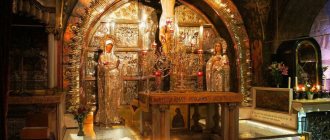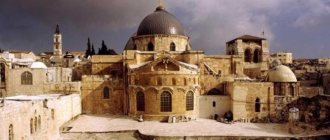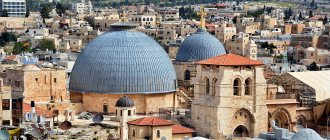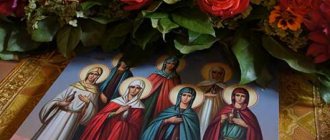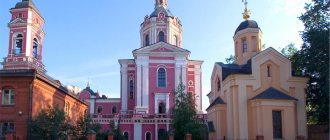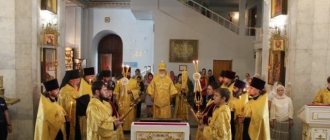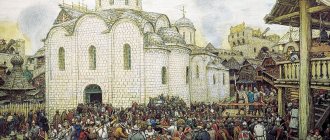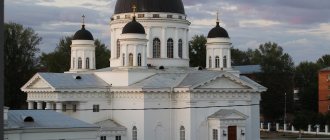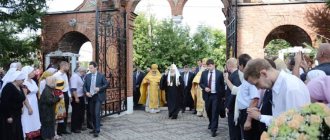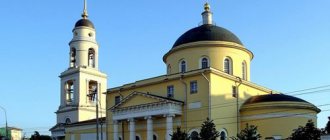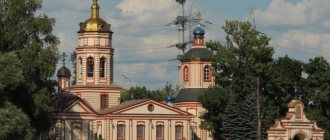To begin with, the Holy Sepulcher is not a “coffin” in the usual sense of the term - that is, a box for a dead body that could be moved from place to place. This is how Abbot Daniel, who visited the Holy Places at the beginning of the 12th century, described the tomb of Jesus: “It’s like a small cave, carved in stone, with small doors through which a person can kneel and enter... And when you enter this cave through small doors, on the right hand - like a bench, carved in the same cave stone: on that bench lay the body of our Lord Jesus Christ. Now that holy bench is covered with marble slabs.”
“The Burial of Christ”, painting by Dirk Bouts
Crucified and Risen
The dimensions of the bench on which the body of Christ rested: length - 2 meters, width - 0.8 meters and height - 0.6 meters. Over the entire cave carved into the rock, they erected a kind of “case” - the Edicule. After the fall of Rome, the masters of Jerusalem were the Arabs, the Crusaders, and the Ottomans. In 1555, the bench-bed of Christ was covered with a new slab. In 1809-1810, Kuvuklia had to be rebuilt after a fire, and in 1927 after an earthquake (reinforced on the outside with steel beams and ties). The body of Jesus was in this tomb for less than three days. In the four Gospels that make up the New Testament, the events are set out as follows. Christ was crucified on Calvary and died on the cross a few hours later. To prevent the torment from dragging on for 2-3 days, the legs of the executed were broken, after which, having lost their point of support, they died of suffocation. When the legs of the two robbers crucified nearby were broken, Jesus was already dead (perhaps the legionnaire Longinus finished him off with a spear). Pilate allowed His body to be given to Joseph of Arimathea and Nicodemus. They wrapped Him in swaddling clothes and laid Him in a tomb, next to which remained the mother of Jesus and Mary Magdalene. The Jewish high priests asked Pilate to place a guard at the tomb. The argument was this: the apostles would steal the body of their teacher and talk about his resurrection. Pilate answered them with irritation: “You have a guard; go and protect it as best you can.” Some kind of security was actually posted. But on Sunday morning thunder struck, an angel descended, the gravestone moved away, and the guards were thrown into the dust. The first to come to the tomb were Mary Magdalene, Peter and John who saw only shrouds in the tomb, which later became another Christian shrine, known as the Shroud of Turin.
This is what the shelf carved into the Tomb on which Jesus lay looked like.
Before He ascended into heaven on the 40th day, Jesus appeared to the two Marys, the apostles, and about five hundred other people. Believers accept the words of the Gospel as undeniable truth. Non-believers, of course, put forward other versions, for example, in the spirit of those expressed by the British historian and writer Robert Graves - they say, Jesus took a certain drug that allowed him to simulate death, then came to his senses, appeared to his disciples and left, leaving behind a legend. In 70, the troops of the future Emperor Titus took Jerusalem after a long siege, suppressing the so-called Jewish uprising. The Romans did not delve into the subtleties of the beliefs of the Jews, and therefore the places associated with the death of Jesus were also desecrated. His tomb was covered with rubbish, later paved with stone, and under Hadrian a temple of Venus was erected on this site.
Edicule of the Church of the Holy Sepulcher
In 313, Emperor Constantine converted to Christianity, and 13 years later his mother, Empress Helena, organized work in Jerusalem during which the Temple of Venus was demolished and the tomb of Jesus was built. At the same time, through the efforts of Elena, the creation of a huge architectural complex began, which today includes Golgotha, as well as the Katholikon (the cathedral church of the Jerusalem Orthodox Church), the underground Church of the Finding of the Life-Giving Christ, the Church of St. Helen Equal to the Apostles, the chapels of six Christian churches representing three branches Christianity. The main structure of the entire complex is the Edicule, a chapel measuring 6 by 8 meters, erected directly above the Holy Sepulcher.
Roof of the Church of the Holy Sepulcher
General information
The Church of the Holy Sepulcher in Jerusalem, or, as it is also called, the Resurrection of Christ, is included in the list of the most significant shrines not only of Jerusalem, but of the entire religious world. It is a huge complex of buildings built on the site of the execution, burial and ascension of the Son of God Jesus Christ. The first mention of the temple, located in the Christian quarter of the historical part of the city, dates back to Art. n. e. Even then, it was the object of a mass pilgrimage of believers arriving in Israel from a variety of countries.
Nowadays, the cult temple complex belongs to six Orthodox denominations - Syrian, Greek, Coptic, Roman Catholic, Armenian and Ethiopian. Each of them has not only its limits, but also hours for prayer. In addition, the head office of the Christian Church of Jerusalem operates in the administrative wing of the Temple. But the main thing is that this is where the annual ritual of the descent of the Holy (Sacred) Fire is held, which is broadcast on television all over the world.
To believe - not to believe
It is in the Edicule on Easter that the miracle of the descent of the Holy Fire takes place. The Patriarch of Jerusalem, wearing only a shirt and previously searched by representatives of other faiths, enters the chapel, from where he emerges after some time with fire, which is believed to have been sent by the Lord himself. The entire territory of the complex is strictly demarcated between representatives of Christian churches, in accordance with the firman of the Turkish Sultan signed back in 1852. The order of services is strictly defined. Not a single lamp or icon can be moved or replaced without the consent of the “neighbors”. Of course, the fact that the Divine Fire is granted only to the Orthodox Patriarch has always caused jealousy and irritation. But when he was removed from the ceremony, the fire did not go down and the believers began to get nervous, fearing the end of the world. In general, such attempts were abandoned. But in the Edicule itself, the patriarch is not alone, but, as a rule, accompanied by several “neutral” witnesses, before whose eyes he bows in prayer before the slab covering the Holy Sepulcher. After some time, the bundle of candles in his hands bursts into flame. Statements are often made that candles are lit by lamps, and such statements come from both adherents and opponents of Orthodoxy. The first speak not of a miracle, but of a ceremony using a lamp and having a symbolic meaning. According to the second, we are talking about a “clever trick” when a lamp previously hidden in the wall is also used to light the candles. Other skeptics try to explain the “trick” by recalling the spontaneous combustion effect that occurs when certain substances come into contact with air. Here everyone decides for himself whether to believe or not to believe. But when archaeologists began working in the tomb in October 2016, at some point all the measuring equipment functioning in the temple failed. She was knocked out by some powerful flow of energy of unknown origin.
The main entrance to the Church of the Resurrection of the Lord. To the left of the entrance is the Column of the Holy Fire. At the top right is the Chapel of Our Lady of Sorrows.
Holy Sepulcher
The Holy Sepulcher is located under the temple named after him. According to the ancient tradition that came to the early Christians from Judaism, the tomb was carved into the rock and was originally a cave. Now only part of the original cave has been preserved, and the Edicule (underground chapel) has been built around the coffin itself.
The relic is a massive stone bed on which the body of Christ was once placed. The Holy Sepulcher was badly damaged by ancient pilgrims, and in order to protect the relic from destruction, it was sealed with a marble slab. The last time the marble slab was changed was in 1555. In 2016, the slab was removed to allow for archaeological research of the Holy Sepulcher.
For the Church of the Resurrection of Christ, the tomb is the main altar. Although there are six churches on the temple grounds, only the Greek Orthodox, Catholic and Armenian Apostolic churches hold services at the Holy Sepulchre.
The Savior's last bed
Archaeologists have also encountered other mysteries. What surprised them most was the bench in the tomb. Under the slab covering it there was a layer of stone fragments, then another slab - marble, with a cross carved on it - and already under it the very surface of the bench on which the body of Christ lay. What did this stone crumble mean? Perhaps the guards took away fragments of stone from the pilgrims, which they tried to take with them as souvenirs, and left them in the cave. During the reconstruction of 1555, for better preservation, the bed itself was covered with a marble slab, the accumulated fragments were piled on this slab and covered with another slab - a stone one. But the most amazing thing was that the surface of the Savior’s bed turned out to be untouched, while its “contemporaries” - the side walls of the cave - were destroyed at the beginning of the 1st millennium, during the reconstruction of the early Church of the Holy Sepulcher. Archaeologist Frederic Hiebert shared his impressions in an interview: “This is absolutely amazing. My knees are shaking because I didn’t expect this... We can’t say with absolute certainty, but at first glance, there is clear evidence that the tomb has not been damaged during all this time.” Further research showed that the bench on which Jesus lay did not have any mechanical damage, chips or deformations, and at the same time an amazing fragrance came from it. The scientific and repair work was successfully completed, but it is unlikely that their results can in any way influence the views of believers and non-believers. A non-believer will find explanations for the most incredible miracle, just as a believer will reject the most logical and convincing arguments of atheists. At the same time, in the history of the Holy Sepulcher there are many gaps and unclear moments. One of the most intriguing mysteries is connected with Russia.
Stone of Anointing
Short story
The mountain on which the Church of the Holy Sepulcher was built in Israel is considered one of the oldest places of worship - people began to come to it since the 2nd century. Unfortunately, scientists have not been able to establish what exactly was here in those distant times. But according to the most popular version, at the top there was a temple dedicated to the goddess of beauty Aphrodite.
Church of St. Helena
The situation changed only several thousand years later, when the mother of Emperor Constantine I, Helena, ordered the construction of a Christian basilica on the site of the pagan altar. During the excavations carried out before the start of construction, she was lucky enough to find unique shrines associated with Jesus! It was about the Life-Giving Cross of the Lord, 4 nails, a tablet with the inscription INRI and a cave in which the Son of God was supposedly buried. It was these findings that served as the reason to dedicate the church to the Messiah. The consecration of the new complex took place in 335 in the presence of the emperor, members of his family and priests who arrived in Israel from other countries.
At the beginning of the 11th century, the Temple of the Resurrection of Christ was almost completely demolished by order of the “mad Egyptian caliph” Al-Hakim-Amrullah. The losses were so great that the subsequent reconstruction of the structure took almost half a century. But these are not all the trials that befell the main shrine of Jerusalem. There were pogroms, natural disasters and serious fires ahead. The last one, which happened in 1808, caused damage to all buildings and decorative elements. This not only entailed further repair work, but also led to big changes “in appearance”.
After Jerusalem was conquered by Saladin's troops, the complex came into Muslim possession. Despite the fact that the Temple was, remains and will be a Mecca for all Christians, the keys to it are kept in an ancient Muslim family. The main reason for this decision was the desire of the religious elite to avoid conflict situations between representatives of different faiths.
Temple architecture
The photos of the Church of the Holy Sepulcher in Israel, presented in tourist brochures, clearly show that it consists of several architectural structures. Let's consider only the main ones.
Main entrance
The facade of the church from the main entrance is considered one of the best examples of Romanesque architecture of the 12th century. Initially, the portal's interconnected lunettes were decorated with marble panels depicting the Burial of the Savior and the Entry of the Lord into Jerusalem. They were later donated to the Rockefeller Museum.
The area located on the right side of the door deserves no less attention. There you can see a wooden hatch that covers the tomb of Philippe d'Aubigné, a French knight who defended Emperor Frederick II upon entering the city. By the way, the door itself is more than one thousand years old - it was founded during the reign of Salah ad-Din.
Column of the Holy Fire
The next attraction of the temple complex is the Corinthian column, made of white marble and decorating the left side of the portal. Unlike other exactly the same pilasters, on one Holy Saturday it simply split. Perhaps the reasons for this phenomenon could be easily explained in terms of physics, but the religious community tends to believe in the divine origin of this defect. The fact is that in those days there were fierce disputes between the Anti-Chalcedonian Armenians and the Orthodox over Easter. The latter celebrated Easter a full 7 days earlier. As a result, the Ottoman ruler ordered the Temple to be locked and Orthodox Christians not allowed to attend the annual service. Outraged by this decision, the believers, led by the clergy Athanasius and Parthenius, came to the doors to pray. Suddenly the wind rose, dark clouds gathered and a powerful roar was heard. He split the column, from the middle of which the Holy Fire suddenly emerged.
Chapel of Our Lady of Sorrows
The Chapel of Our Lady of Sorrows is a small structure rising at the eastern end of the courtyard and serving as the antechamber of the Calvary chapel. It is often called the Franconian Chapel or the Chapel of the Removal of the Robes - this is due to the events that occurred after the execution of Jesus Christ. Scientists believe that it was in this room that Roman soldiers were busy dividing up the belongings of the deceased Messiah.
Triumphal Arch
Picturesque photographs of the Church of the Holy Sepulcher in Jerusalem (Israel) indicate that the Triumphal Arch or Arch of Monomakh, connected to the interior by only a small step, is one of the most beautiful structures of the complex. It was built in memory of Constantine IX, the Roman ruler who carried out the restoration of the church in 1048.
The main decoration of this structure can be called the balconies, arranged on both sides of the passage and turned towards the Edicule. Until 1917, they housed consuls, presidents and honored guests from the main Orthodox states who came to Israel for ceremonial services. In addition, under the arch you can see a stone lintel with an inscription glorifying the “Mother of the Churches of God.”
Stone of Anointing
The Stone of Anointing in the Church of the Holy Sepulchre, lying right at the entrance, is hidden behind a slab of white marble. Everyone who comes here wants to touch it, because it was in this place, according to ancient legends, that the crucified Christ lay. There are 8 lamps burning above the sacred relic, symbolizing the spheres of influence of religious denominations. The stone streams myrrh with a mixture that contains 40 components not found in nature. These include incense, which our ancestors used to cleanse the bodies of the dead before burial.
For several decades, scientists have been trying to understand the nature of this phenomenon. But neither round-the-clock video recordings, nor close observation of the stone, nor all kinds of analyzes yielded anything. However, thousands of pilgrims who come to Israel are not looking here for scientific evidence and explanations, but for peace and the opportunity to be healed.
Interior decoration
The Church of the Holy Sepulcher in Jerusalem, photos of which are present in most tourist brochures in Israel, consists of 3 parts.
Temple of the Resurrection
The Church of the Resurrection of the Lord or Katholikon, located in the central part of the complex, is separated from others by walls that do not reach the ceiling. It originally included several sanctuaries, but Greek reconstruction radically changed the overall structure of the structure. In addition to the side walls, which also appeared after its completion, a high iconostasis, two throne seats (for the Patriarch of Israel and his epitrope), as well as a gallery with three balconies from which the priest reads the texts of the Gospel were installed in the church.
Under the dome of the Katholikon, rising above its northern part, there is a “mesomphalos”. It is a marble hemisphere placed on a special stand and pointing to the so-called “navel of the Earth”. The dome itself is decorated with a mosaic depicting 12 saints, the Virgin Mary, St. John and the two main guardian angels - Gabriel and Michael. The niches between the windows are decorated with portraits of angels made today. The Church of the Lord's Resurrection is surrounded by wide galleries. In one of them you can see the Arcade of the Virgin - majestic 4-sided obelisks and columns, among which you can see the remains of the marble structure of Emperor Hadrian.
Calvary Temple
You can get to this area of the temple complex via a staircase of 13 steps located at the entrance to the Catholicon. There are 2 naves (for Orthodox and Catholics) and a hole in the ground from where the cross was removed (indicated by a silver circle). By lowering your hand into the recess, you can touch Golgotha, the place where Christ was executed. Next to the silver circle there are 2 black ones - they indicate the crosses of the criminals killed along with the Prophet. There is a fairly noticeable crack in the nearby rock. They say that she appeared simultaneously with the last breath of the martyr.
In addition, another interesting legend is associated with Golgotha in Israel. It is believed that Adam, the progenitor of all humanity, expelled from Paradise due to the Fall, was buried at the site of the future crucifixion. The blood of Christ, seeping through the earth, fell on the remains of the first man and atoned for sins.
Chapel of the Holy Sepulcher
The marble Edicule, built over the Holy Sepulcher, includes two parts - the cave that became the tomb of Jesus, and the Angelic Chapel. It is here that the Holy Fire is lit on Easter Saturday, which is then spread throughout the planet.
In the middle of the chapel there is a pedestal with a piece of sacred stone broken off by an angel. During the liturgy it is used as a throne. There are lamps burning along the wall - 15 pieces in 3 rows (according to the number of confessions). The entrance to Edicule is decorated with a marble portal, on one side of which the Archangel Gabriel is depicted, and on the other - the Myrrh-Bearing Women. The marble canopy located at the top of the portal deserves no less attention. The inscription on it indicates the resurrection of the Son of God.
The main attraction of the chapel is the Three-Day Stone Bed of Christ, installed in a small chamber. It was once freely accessible, but in 1812 it was covered with a marble slab, protecting the shrine from vandals. On the shelves nailed near the Triday Bed are icons of the Resurrection - one from each Orthodox denomination.
How to get there?
The Church of the Holy Sepulcher in Jerusalem (Israel) is located at 1 Helena Str., Old City, POB 186, Jerusalem. There are several ways to get into it.
Method 1. On foot from the Old Town
You can enter the territory of the main Israeli shrine both from the Christian Quarter and from the street. Suk Khan al-Zeit.
Method 2. By bus:
- No. 99, 13, 41, 19, 30, 20 transport - go to the Jaffa Gate of Old Jerusalem;
- No. 38 – runs to the Jewish Quarter;
- No. 1, 2, 3 and 21 - stop at the Damascus Gate.
Important! It is better to check the route at the hotel reception.
Method 3. By light metro
The Jerusalem elevated metro, more reminiscent of a regular tram, is represented by one line - “City Hall” - “Damascus Gate”. The first station is located near the New Gate. The second is near Damascus.
Method 4. By taxi
This option is considered not only the most convenient, but also the most expensive. For those who want to save money, we advise you to get off near the New Gate - they are closest to the Temple.
Working hours
The opening hours of the temple complex in Israel depend on the time of year.
Summer (April – September):
- Mon.-Sat. – from 5.00 to 21.00;
- Sun. – from 5.00 to 20.00.
Winter (October – March):
- Mon.-Sun. from 4.00 to 19.00.
Important! More detailed information can be obtained on the official website: churchoftheholysepulchre.net/
Useful tips
When deciding to visit the shrine, be sure to consider several important points:
- The smallest influx of tourists is observed in the early morning (around 8.00) and in the evening (16.00-17.00). At this time, you can calmly explore the sights, take pictures for memory and touch the stone of anointing in the Church of the Holy Sepulchre;
- The complex often closes a little later than the specified time, so do not rush to leave its territory;
- Before your trip, find out if there are any major Christian holidays during your stay in Jerusalem. Due to the huge number of pilgrims, it will be difficult to get into the church;
- Anyone can attend daily services. The only condition is proper appearance and compliance with basic rules;
- The temple has a dress code, so during its visit you cannot wear short skirts, shorts, dresses with a neckline, high-heeled shoes, as well as tight and too bright outfits. Women must cover their heads with a scarf;
- Don’t forget to choose comfortable shoes that are as closed as possible – you will have to walk a lot here;
- If you want your loved ones to be mentioned during prayer, write their names on a piece of paper and give it to one of the monks. There should be no more than 10 names, case – nominative, text – in Cyrillic. There should be no unnecessary words, because the notes are read by clergy who do not know the Russian language.
And one more nuance. After visiting the complex, many people ask how to use candles from the Church of the Holy Sepulchre. Firstly, it should be noted that they are sold in bunches of 33 pieces each. It is customary to set Jerusalem candles on fire from the Holy Fire and extinguish them with a special cap or bare hands (you cannot blow out the beam). Next, the bundle is taken home, without under any circumstances dividing it into parts. It is believed that Jerusalem candles contain life-giving power and are an incredibly powerful amulet. Moreover, every candle lit from the sacred bunch receives these same qualities.
The Church of the Holy Sepulcher in Jerusalem (Israel) is not only an important historical landmark, but also the main symbol of the Christian religion. Everything here is so saturated with the spirit of that time that even complete atheists begin to feel heavenly grace. Don't believe me?! Well, you have every chance to experience it for yourself. Have a good rest and new amazing discoveries!
Author: Olga Musienko
The defeat of the crusading "special forces"
It is believed that the earliest slab covering the bed of the Savior was sent to the capital of the Byzantine Empire. However, in 1204, having received a report from the crusaders who had captured Constantinople, Pope Innocent III was horrified to discover that this slab was not on the list of captured shrines. Where did she go? One of the Novgorod epics tells how Vasily Buslaev took the lid of the Holy Sepulcher to Rus'. The epic, of course, is a work of art, but Buslaev cannot with all responsibility be called a historical figure. But here is an entry from the IV Novgorod Chronicle, dated “In the summer of 6719” (that is, in 1211), which speaks of a character who existed in reality: “Then Dobrynya Yadreikovich came from Constantinople and brought with him the Holy Sepulcher, and he himself was tonsured on Khu-tyn near the Holy Savior.” So, a certain Novgorod boyar Dobrynya Yadreikovich, returning to his homeland seven years after the capture of Tsar-grad by the “Latins”, brought with him the “Holy Sepulcher”. It is logical to assume that it was not about the Tomb, but about the slab that covered the last bed of Christ. During the destruction of Constantinople, the brave Novgorodian tried to save the shrine from the crusaders, in whom he (considering the then conflicts between Orthodox and Catholics) saw not so much defenders as desecrators of the faith of Christ. Such an act required a great reward, and, in general, it is clear that, having become a monk, he soon became the abbot of perhaps the most revered Varlaam-Khutyn monastery in the Novgorod lands. However, the news that the slab from the Holy Sepulcher was in the possession of the schismatics, of course, reached the “Latins” and should have caused them to be furious. Does this not explain the strange campaign of the “dog knights” of 1240, which ended with the Battle of the Neva? It raises too many questions, both because of its motivation, and because of the small number of the crusader army, and because of the enormous resonance that, in essence, a border skirmish caused on the scale of Rus'. Everything falls into place if we assume that the detachment of crusaders was not going to conquer Novgorod, but only to capture a shrine that was important for the entire Christian world. But, having landed at the mouth of Izhora, the European “special forces” relaxed, and local residents warned Prince Alexander. He took advantage of the enemy’s relaxation, struck a sudden blow and won a victory, which in the eyes of his fellow tribesmen was perceived as evidence that God had not yet abandoned Holy Rus'. However, given that Rus' was under the yoke of the Mongols, they somehow did not want to run into additional troubles, and the Novgorodians tried not to advertise the fact of owning such an important shrine. Could everything have been exactly like this? Why not?
Confessions and the orders they established
Since the temple is the basis of Christianity, six denominations have the rights to hold services inside it. All of them have their own chapel, and each is assigned certain hours for prayer. Thus, Golgotha and the Catholicon were given to the Orthodox Church. The Liturgy in Edicule is held in turns at different hours.
To ensure a peaceful situation in relations between faiths, the keys to the temple have been handed over to a Muslim family since 1192. The right to open the gate is given to another Muslim family. The custodians of the keys are immutable, and responsibilities in both cases are inherited.
Moscow trace
After 1492, mentions of the shrine’s presence in Novgorod disappear from the chronicles, but, in general, it is not so difficult to imagine where it could have gone—to Moscow. And, of course, it should have been kept in the main Kremlin cathedral - the Assumption. In 1610-1612, a Polish-Lithuanian garrison was stationed in the Kremlin, whose leaders, at the first opportunity, would not fail to send such a relic to their homeland. But, apparently, this opportunity was not taken advantage of. Historian Andrei Sinelnikov noted that modern descriptions of the Assumption Cathedral include an exhibit designated as a “tent for relics.” The inscription on it reads: “By the grace of God, with the blessing and at the command of the great lord, His Holiness Patriarch Philaret... under the power of the faithful and noble Christ-loving great sovereign... Mikhail Fedorovich of All Russia, autocrat... in three for the tenth year of the state..., in the sixth year of the patriarchate of Philaret, Patriarch of Moscow and All Rus' made this lattice into the cathedral church near the Holy Sepulcher in the summer of 7133, the month of September, 30 days.” That is, it turns out that the tent was intended specifically for storing the lid of the Holy Sepulcher, and in 1625 (7133 in the inscription) it was still available. But where did it go afterwards? Is the Moscow fire of 1812 or the Bolshevik anti-God campaign in the 1920s and 1930s to blame for this? However, it is possible that even today this shrine is kept in the Assumption Cathedral among unattributed—or not advertised—items.
Sensation or mistake?
In 1980, a crypt was found in the East Talpiot neighborhood of Jerusalem, which, according to documentarian Simcha Jacobovitch and Titanic author James Cameron, is the real tomb of not only Jesus, but also members of his family. The crypt contained ossuaries - stone boxes in which the bones of the deceased were placed after they had dried out on a shelf in the tomb. From the inscriptions on the ossuaries it follows that they contain the remains of “Jesus, the son of Joseph,” one of his brothers, Josiah, the remains of two Marys, some Mati (possibly the Apostle Matthew) and a man called “Judas, the son of Jesus.”
Author: Maxim Lukoshkov
Magazine: Mysteries of History No. 13, March 2022
